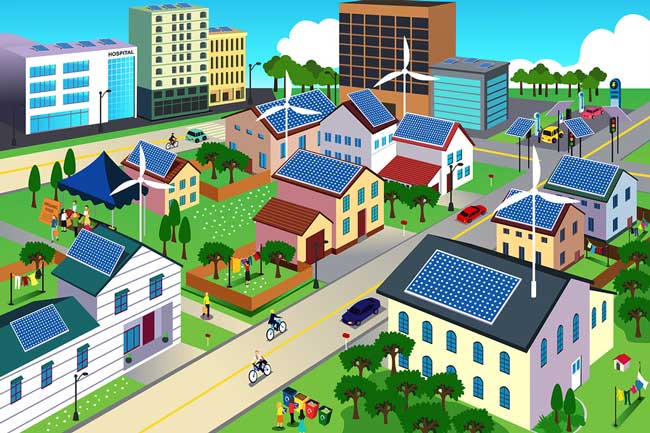What role will community-based solar microgrids play as Aussies look for environmental and affordable energy alternatives?
First, I should explain what a microgrid actually is. It is simply a cluster of buildings, all connected together electrically, but not connected to the wider electric grid. An example would be taking your whole street off the grid instead of simply your own home. If you do this, you can share solar generation and battery storage among other things. As feed in tariffs get lower, this becomes more attractive. Wouldn’t you rather your sell excess solar energy to your neighbour for a fair price than be forced to sell it to someone like Energex for a miserly 6c per kWh?
According to analysts Frost and Sullivan’s report “Analysis of the Asia-Pacific Microgrid Market” the microgrid electrification (including solar programs) is expected to reach a sales figure of $813 million by 2020, growing at an expected astonishing rise of 38.3 percent over that of 2013. Countries surveyed by Frost and Sullivan include Japan, Indonesia, South Korea, Malaysia, the Philippines and (yes!) Australia.
While unplugging from the grid isn’t yet a financial option for most people, research by Energy for the People has found that microgrids will be cost effective before 2020. Coupled with breakthroughs in battery storage technology, the strengthening position of solar microgrids in our future energy market is one that is being taken very seriously.
Already solar microgrids have been employed as a key component of the UN’s Millennium Development Goals, with the aim of empowering (literally) local communities with technology for a fast and reliable source of energy. As well as training and equipment, aid recipients receive cost effective technologies such as solar panels, generators that set up communities as virtual solar microgrids.
Microgrids then have proved that they are highly suited to smaller communities where the cost of running energy infrastructure such as poles and wires is prohibitive.
So what of the future? Are we to see the benefits of community solar power driven by intriguing initiatives such as solar microgrids in developed nations’ energy systems? Will the increasing use of such microgrids in communities in the developing world translate to countries such as Australia?
With the recent massive price hike from electricity and gas companies (caused by over-investment and mismanagement by the big energy companies NOT the carbon tax), solar microgrids are now more affordable in comparison, particularly in isolated communities.
Australians have always had an independent streak, preferring to rely on their own nous and resourcefulness rather than government programs and big companies. This is shown quite clearly in the renewable energy sector where government support has been reduced to laughable levels with the fate of the RET seemingly in the hands of minor parties.
Consequently much of Australia’s solar sector growth has been driven by individual Aussies making decisions over the future of their energy. Coupled with the falling cost of battery storage, solar microgrids, particularly in rural areas, is now approaching viability.
Recent government inaction towards renewables has convinced Aussies that only action on the individual and community level will reap rewards on implementing renewable energy, so why not consider solar microgrids?


 RSS - Posts
RSS - Posts



I am already a solar convert. Great post…. but now you need to address what we do with our excess of day time production.. i.e. storage for our night time consumption, instead of exporting our production during the day for as you say returns as low as 6c per kw. to buy it back at night at approaching 30c Kw incl GST
Thanks for your comments Roncher. Thought-provoking comment, yes storage is the next frontier!
Great idea! ~ but producing (there IS limited space for installing panels) and storing that amount of energy poses enormous risks and problems….one of which is having to employ someone/people (with the qualifications) to run and maintain it all: which would mean a power bill to pay wages. (and given people’s addiction to unlimited electrical power 24/7. How are you going to regulate how much power any individual can take from the community grid, regardless what price he may be prepared to pay?
eg. Could I use ALL the ‘overnight power’ in the community battery-bank if I was willing to pay, say, $20 per KWH?
Another problem (insurmountable from where I sit) is –> “Wouldn’t you rather your sell excess solar energy to your neighbour for a fair price than be forced to sell it to someone like Energex for a miserly 6c per kWh?”. WHO is going to decide what “a fair price is” ~ and HOW would that be decided? Democratic vote ~ enforced on those who disagree?
And the obvious corollary:- what if someone refuses to join the microgrid for financial or other reasons?
etc.etc.etc.
….. in the end wouldn’t you finish up with an even more confusing (and expensive) ‘Electricity Authority’ than we have now?
The only realistic solution is that every individual property have it’s own stand-alone system ~ including storage ~ sized to meet the needs of the property-owner (as decided by him) so that there isn’t ANY excess power produced.
…. then we can all work on how to deal with the situation that arises where your neighbour’s tree (or house for that matter) blocks your access to the sun…………!
Have a good day!